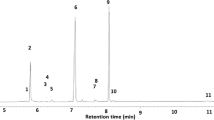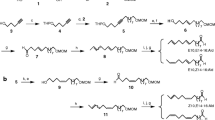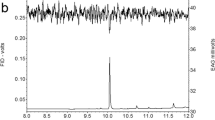Abstract
Five active compounds were detected during analyses of ovipositor washings and effluvia from virgin female Coniesta ignefusalis moths by gas chromatography (GC) linked to electroantennographic (EAG) recording from a male moth. These were identified as (Z)-7-dodecen-1-ol (Z7–12:OH), (Z)-5-decen-1-ol (Z5–10:OH), (Z)-7-dodecenal (Z7–12:Ald), (Z)-7-dodecenyl acetate (Z7–12:Ac), and (Z)-9-tetradecen-1-ol (Z9–14:OH) by comparison of their GC retention times, mass spectra, and EAG activities with those of synthetic standards. Laboratory tests of dispensers for these compounds showed that release rates from polyethylene vials increased to relatively uniform values after three to four days, but release from septa was very rapid and nonuniform and decreased to low levels after two to three days. Trapping tests in Niger showed that the major component, Z7–12:OH, and two of the minor components, Z5–10:OH and Z7–12:Ald, were essential for attraction of male C. ignefusalis moths. The most attractive blend contained these three components in a 100:5:3.3 ratio in a polyethylene vial, which emitted the components in similar proportions to those produced by the female C. ignefusalis moth. Water traps baited with this blend containing 1 mg of Z7–12:OH caught more male C. ignefusalis moths than traps baited with newly emerged female moths. Addition of up to 10% of the corresponding E isomers of the pheromone components had no effect on catches, but addition of the other two minor components detected, Z7–12:Ac and/or Z9–14:OH, to the attractive blend at naturally occurring levels caused significant reductions in trap catch.
Similar content being viewed by others
REFERENCES
Ajayi, O. 1990. Possibilities for integrated control of the millet stem borer, Coniesta ignefusalis, Hampson (Lepidoptera: Pyralidae) in Nigeria. Insect Sci. Appl. 11:109–117.
Arn, H., Toth, M., and Priesner, E. 1998. PheroList: List of sex pheromones of Lepidoptera and related attractants. http://nysaes.cornell.edu/pheronet/
Attygalle, A. B., Herrig, M., Vostrowsky, O., and Bestmann, H. J. 1987. Technique for injecting intact glands for analysis of sex pheromones of Lepidoptera by capillary gas chromatography. Reinvestigation of pheromone complex of Mamestra brassicae. J. Chem. Ecol. 13:1299–1311.
Bako, O. 1977. Étude biologique de Haimbachia ignefusalis (Hamps.) (Lepidoptera: Pyralidae, Crambinae) en vue d'une lutte biologique. Thèse maitrise. Université Laval, Quebec, Canada.
Beevor, P. S., Cork, A., Hall, D. R., Nesbitt, B. F., Day, R. K., and Mumford, J. D. 1986. Components of the female sex pheromone of the cocoa pod borer moth, Conopomorpha cramerella. J. Chem. Ecol. 12:1–23.
Berger, R. S. 1966. Isolation, identification and synthesis of the sex attractant of the cabbage looper, Trichoplusia ni. Ann. Entomol. Soc. Am. 59:767–771.
Biostad, L. B., Linn, C. E., Du, J.-W., and Roelofs, W. L. 1984. Identification of new sex pheromone components in Trichoplusia ni, predicted from biosynthetic precursors. J. Chem. Ecol. 10:1309–1323.
Butler, L. I., and McDonough, L. M. 1981. Insect sex pheromones: Evaporation rates of alcohols and acetates from natural rubber septa. J. Chem. Ecol. 7:627–633.
Christie, W. W. 1988. Equivalent chain lengths of methyl ester derivatives of fatty acids on gas chromatography: A reappraisal. J. Chromatogr. 447:305–314.
Cork, A., Beevor, P. S., Gough, A. J. E., and Hall, D. R. 1990. Gas chromatography linked to electroantennography: A versatile technique for identifying insect semiochemicals, pp. 271–279, in A. R. McCaffery and I. D. Wilson. Chromatography and Isolation of Insect Hormones and Pheromones. Plenum Press, New York.
Dunkelblum, E., and Gothilf, S. 1983. Sex pheromone components of the gamma moth, Autographa gamma, (L.) (Lepidoptera: Noctuidae). Z. Naturforsch. 38c:1011–1014.
Dunkelblum, E., Snir, R., Gothilf, S., and Harpaz, I. 1987. Identification of sex pheromone components from pheromone gland volatiles of the tomato looper, Plusia chalcites (Esp.). J. Chem. Ecol. 13:991–1003.
FrÉrot, B., Dugdale, J. S., and Foster, S. P. 1993. Chemotaxonomy of some species of moths in the New Zealand genus Graphania based on sex pheromones. N.Z. J. Zool. 20:71–80.
Grob, K., and Zurcher, F. 1976. Stripping of organic trace compounds from water. Equipment and procedure. J. Chromatogr. 117:285–294.
Harris, K. M. 1962. Lepidopterous stem borers of cereals in Nigeria. Bull. Entomol. Res. 53:139–171.
Harris, W. E., and Habgood, H. W. 1966. Programmed Temperature Gas Chromatography. John Wiley & Sons, New York.
ICRISAT (International Crops Research Institute for the Semi-Arid Tropics). 1989. ICRISAT West African Programmes Annual Report, 1988. BP 12404, Niamey, Niger: ICRISAT Sahelien Center.
LÖfstedt, C., Van Der Pers, J. N. C., LÖfqvist, J., Lanne, B. S., Appelgren, M., BergstrÖm, G., and Thelin, B. 1982. Sex pheromone components of the turnip moth, Agrotis segetum: Chemical identification, electrophysiological evaluation and behavioural activity. J. Chem. Ecol. 8:1305–1321.
LÖfstedt, C., Lanne, B. S., LÖfqvist, J., Appelgren, M., and BergstrÖm, G. 1985. Individual variation in the pheromone of the turnip moth, Agrotis segetum. J. Chem. Ecol. 11:1181–1196.
LÖfstedt, C., LÖfqvist, J., Lanne, B. S., Van Der Pers, J. N. C., and Hansson, B. S. 1986. Pheromone dialects in European turnip moths, Agrotis segetum. Oikos 46:250–257.
Mazor, M., Harel, M., Levsky, S., and Dunkelblum, E. 1991. Sex pheromone components of female Cornutiplusia circumflexa. Entom. Exp. Appl. 60:167–172.
McDonough, L. M., and Butler, L. I. 1983. Insect sex pheromones: determination of half-lives from formulations by collection of emitted vapour. J. Chem. Ecol. 9:1491–1502.
N'doye, M., and Gahukar, R. T. 1987. Insect pests of pearl millet in West Africa and their control, pp. 195–205, in Proceedings of the International Pearl Millet Workshop, April 7–11, 1986. ICRISAT Center, Patancheru, India AP.
N'doye, M., Gahukar, R. T., Carson, A. G., Selvaraj, C., M'baye, D. F., and Diallo, S. 1984. Situation of plant protection problems of millet crop in the Sahel, p. 18, in Proceedings of International Seminar: CILSS Pest Management Project, Niamey, December 6–13.
Nesbitt, B. F., Beevor, P. S., Lester, R., Davies, J. C., and Seshu Reddy, K. V. 1979. Components of the sex pheromone of the spotted stalk borer, Chilo partellus. (Swinhoe) (Lepidoptera: Pyralidae): Identification and preliminary field trials. J. Chem. Ecol. 5:153–163.
Nesbitt, B. F., Beevor, P. S., Cork, A., Hall, D. R., David, H., and Nandagopal, V. 1986. The female sex pheromone of sugarcane stalk borer, Chilo auricilius. Identification of four components and field tests. J. Chem. Ecol. 12:1377–1388.
Priesner, E. 1987. (Z)-5-Dodecen-1-ol, another inhibitor of pheromonal attraction in Coleophora laricella. Z. Naturforsch. 42c:1349–1351.
Priesner, E. 1989. Two-component sexual attractant for male Batrachedra pinicolella (Zell.) (Lepidoptera: Batrachedridae). Z. Naturforsch. 44c:1061–1062.
Priesner, E., and Zhang, Q.-H. 1991. Field response of male eastern casebearer Coleophora dahurica Flkv. (Lep., Coleophoridae) to synthetic sex-attractant and attraction inhibitors. J. Appl. Entomol. 112:321–326.
Priesner, E., Altenkirch, W., Baltensweiler, W., and Bogenschutz, W. 1982. Evaluation of (Z)-5-decen-1-ol as an attractant for male larch casebearer moths, Coleophora laricella. Z. Naturforsch. 37c:953–966.
Sower, L. L., Coffelt, J. A., and Vick, K. W. 1973. Sex pheromone: A simple method of obtaining relatively pure material from females of five species of moths. J. Econ. Entomol. 66:1220–1222.
Struble, D. L., Bryers, J. R., Shepherd, R. F., and Gray, T. G. 1989. Identification of sex phermone components of the black army cutworm, Actebia fennica (Tauscher) (Lepidoptera: Noctuidae), and a sex attractant blend for adult males. Can. Entomol. 121:557–563.
Sugie, H., Kawasaki, K., Nakagaki, S., and Iwata, N. 1991. Identification of sex pheromone of the semi-looper, Autographa nigrisigna Walker (Lepidoptera: Noctuidae). Appl. Entomol. Zool. 26:71–76.
Toth, M., and SzÕcs, g. 1991. (Z)-7-Dodecenol attractive to male Agrotis segetum Den. & Schiff. (Lep., Noctuidae) in the field. J. Appl. Entomol. 112:202–206.
Tumlinson, J. H., Heath, R. R., and Teal, P. E. A. 1982. Analysis of chemical communication systems of Lepidoptera, pp. 1–25, in B. A. Leonhardt and M. Beroza (eds). Insect Pheromone Technology: Chemistry and Applications, ACS Symposium Series 190. American Chemical Society, Washington, D.C.
Underhill, E. W., Rogers, C. E., and Hogge, L. R. 1987. Sex attractants for two sunflower pests, Eucosma womonana (Lepidoptera: Tortricidae) and Isophrictis similiella (Lepidoptera: Gelechiidae). Environ. Entomol. 16:463–466.
Youm, O., and Beevor, P. S. 1995. Evaluation of pheromone-baited traps for Coniesta ignefusalis (Lepidoptera: Pyralidae) in Niger. J. Econ. Entomol. 88:65–69.
Youm, O., and Gilstrap, F. E. 1993. Population dynamics and parasitism of Coniesta (= Haimbachia) ignefusalis, Sesamia calamistis and Heliocheilus albipunctella in millet monoculture. Insect Sci. Appl. 14:419–426.
Youm, O., Beevor, P. S., and Hall, D. R. 1993. Trap design studies with the pheromone of Coniesta ignefusalis (Hampson) (Lepidoptera: Pyralidae) in sub-Saharan Africa, pp. 58–63, in P. S. Beevor, L. J. McVeigh and D. R. Hall (eds.). Proceedings IOBC/WPRS Working Group “Use of Pheromones and Other Semiochemicals in Integrated Control,” Chatham, UK, May 11–14, 1993, Vol. 16.
Youm, O., Harris, K. M., and Nwanze, K. F. 1996. Coniesta ignefusalis (Hampson), the millet stem borer: A handbook of information. Information Bulletin No. 46. ICRISAT, Patancheru 50234, Andhra Pradesh, India, 60 pp.
Youm, O., Beevor, P. S., Hall, D. R., and McVeigh, L. J. 1997. The potential use of pheromones for the management of the millet stemborer, Coniesta ignefusalis (Hampson). Insect Sci. Appl. 17:169–173.
Author information
Authors and Affiliations
Rights and permissions
About this article
Cite this article
Beevor, P.S., Youm, O., Hall, D.R. et al. Identification and Field Evaluation of Components of Female Sex Pheromone of Millet Stem Borer, Coniesta ignefusalis . J Chem Ecol 25, 2643–2663 (1999). https://doi.org/10.1023/A:1020839221609
Issue Date:
DOI: https://doi.org/10.1023/A:1020839221609




